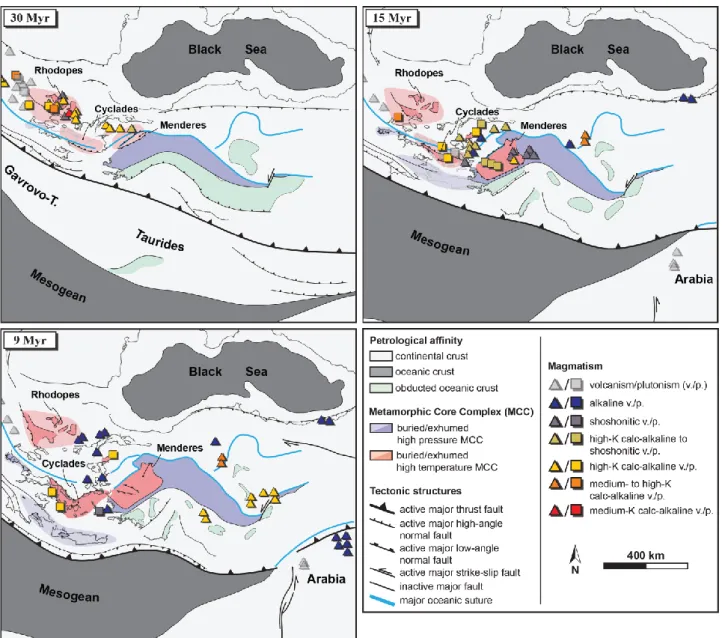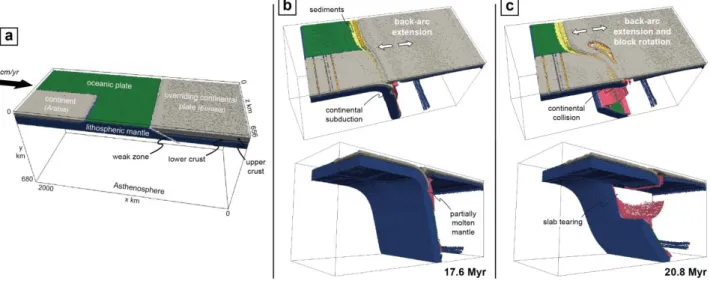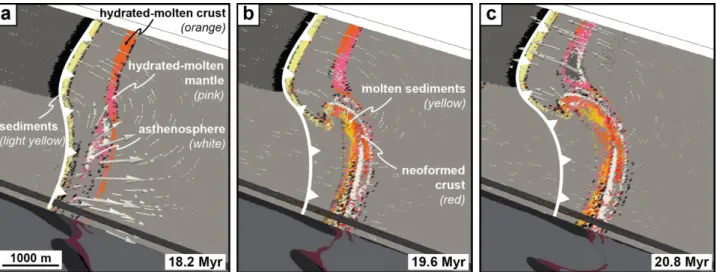HAL Id: hal-00991329
https://hal-brgm.archives-ouvertes.fr/hal-00991329
Submitted on 15 May 2014HAL is a multi-disciplinary open access archive for the deposit and dissemination of sci-entific research documents, whether they are pub-lished or not. The documents may come from teaching and research institutions in France or abroad, or from public or private research centers.
L’archive ouverte pluridisciplinaire HAL, est destinée au dépôt et à la diffusion de documents scientifiques de niveau recherche, publiés ou non, émanant des établissements d’enseignement et de recherche français ou étrangers, des laboratoires publics ou privés.
Crustal deformation and magmatism at the transition
between subduction and collisional domains: insights
from 3D numerical modeling
Armel Menant, Pietro Sternai, Laurent Jolivet, Laurent Guillou-Frottier,
Taras Gerya
To cite this version:
Armel Menant, Pietro Sternai, Laurent Jolivet, Laurent Guillou-Frottier, Taras Gerya. Crustal defor-mation and magmatism at the transition between subduction and collisional domains: insights from 3D numerical modeling. GEOMOD 2014 : Modelling in Geoscience, Aug 2014, Potsdam, Germany. pp.289-293, �10.2312/GFZ.geomod.2014.001�. �hal-00991329�
Crustal deformation and magmatism at the transition between subduction and
collisional domains: insight from 3D numerical modeling
Armel Menant 1,2,3, Pietro Sternai 1,2,3, Laurent Jolivet 1,2,3, Laurent Guillou-Frottier 2,1,3, Taras Gerya 4
1
Université d’Orléans, ISTO, UMR 7327, Orléans, France (armel.menant@cnrs-orleans.fr) 2
BRGM, ISTO, UMR 7327, 45060 Orléans, France 3
CNRS/INSU, UMR 7327, 45071 Orléans, France 4
Swiss Federal Institute of Technology (ETH), Zurich, Switzerland
Geodynamics evolution of subduction zones is often complex, notably due to the variable nature and rheology of interacting lithospheres, 3D slab geometry and related mantle flow. In order to understand the temporal evolution of this dynamics, the long-term geological record should be considered, including the present-day kinematics, the long-term history of deformation and magmatism within the upper plate. This leads to conceptual models that imply complex physical process that can be tested through numerical modeling.
In this study, we focus on the eastern Mediterranean region where a long-lived subduction zone has been active since the Mesozoic. In this region, the Tethyan active margin is notably characterized by successive subductions of oceanic and continental ribbons, slab retreat episodes and possible slab tearing processes, notably interpreted from tomographic models showing low-velocity anomaly below Anatolia [Ricou et al., 1986; Piromallo and Morelli, 2003; van Hinsbergen et al., 2005a; Jolivet et al., 2013].
Using G-Plates software, we first modeled the kinematic evolution of the eastern Mediterranean in the last 100 Myrs, accounting for a large number of geological data, including the magmatic occurrences (figure 1). Since 35-30 Ma, the geodynamics of this region has been dominated by the subduction and collision of Arabia with Eurasia and with the development of a large back-arc domain in the Aegean region, resulting from an increase of the rate of slab retreat. This slab retreat is associated with the southward migration of high-potassic magmatism in the back-arc domain with time, and with the southwest fast migration of the Aegean plutons during the middle Miocene from the Menderes to the Cyclades (figure 1).
In addition, a major change occurred in the dynamics of the back-arc opening in the middle Miocene (figure 1) with a new increase of the rate of trench retreat and large-scale block rotations on the edge of this extensional domain in the Hellenides and in western Anatolia [Kissel and Laj, 1988; van Hinsbergen et al., 2005b]. This kinematic change is coeval with the southwest migration of the back-arc plutons and with the increase of their mantle component compared to their crustal component from east to west [Altherr and
Siebel, 2002]. Finally, sparse alkaline volcanism emplaced in the Aegean and western Anatolia since ~15 Ma
with the same westward migration trend, indicating a hot asthenospheric upwelling associated with a low rate of partial melting [Dilek and Altunkaynak, 2009].
Figure 1: Kinematic reconstructions of eastern Mediterranean region at 30, 15 and 9 Ma, highlighting the main metamorphic, tectonic and magmatic features.
Using high-resolution 3D thermo-mechanical numerical modeling, we reproduce a relatively simple model of retreating subduction neighboring a collisional domain that we compare with these geological observations. These numerical experiments are performed with the code I3ELVIS, considering non-newtonian visco-plastic rheologies and notably integrating partial melting and melt extraction processes as well as fluid and melt transport mechanism [Gerya and Yuen, 2003; Zhu et al., 2013]. The resolved grid has a resolution of 3.4, 2.5 and 4.4 km in the x,y and z dimensions respectively and ~130 million additional randomly distributed moving markers.
The initial model setup shows an oceanic lithosphere and a continental plate (considered as Arabia) converging toward a continental upper plate (considered as Eurasia) (figure 2a). The evolution of the model shows first the subduction of the oceanic crust then of the continental crust below the upper plate margin that is stretched as a result of the trench retreat (figure 2b). When the contient buoyancy and the slab pull forces
overstep the strength of the lithosphere, the slab is torn first horizontally then vertically along the subducted continental margins (figure 2c). The slab tear results in the exhumation and the rebound of the subducted continental crust and the establishing of a collisional regime (figure 2c). Aside of the collisional domain, the oceanic subduction protracts for longer and slab roll-back and trench retreat occur as faster rates since the slab tearing reduced the along-strike dimension of the slab (figure 2c). Consequently, the upper plate extension rates increase and strike-slip deformation accommodates the rotation of crustal blocks.
Figure 2: 3D thermo-mechanical modeling of retreating subduction neighboring a collisional domain. (a) Initial setup of the 3D model domain with colors showing different rock types. (b, c) Evolution of the reference model at 17.6 and 20.8 Myr. The top layer (“sticky air”", y < ~12 km) and the asthenosphere are cut off for clarity.
The rebound of the subducted continental crust following the slab tearing, combined with 3D mantle flow, carries partially molten mantle wedge toward the base of the stretched upper continental plate (figure 3a). This material then migrates progressively toward the subducting oceanic plate replacing progressively the partially hydrated and molten crustal material previously developed in the back-arc region (figures 3b and 3c). Finally, asthenospheric material rises at the base of the crust, undergoing a possible adiabatic partial melting inducing the development of an alkaline volcanism at the surface (figure 3).
Results from these numerical experiments show a tectonic and magmatic evolution that can be compared to the geological observations across the eastern Mediterranean region. This exercise shows the potential of this double-sided approach involving an independent reconstruction of the long-term evolution of subduction zones based on kinematic reconstructions and 3D thermo-mechanical numerical modeling to investigate the complex interactions between slab behavior, magmatic history, mantle flow and crustal deformation.
Figure 3: 35 km-depth horizontal cross-section of the reference model, corresponding to the base of the stretched continental crust, highlighting the different hydrated and partially molten phases. (a, b, c) Evolution of the model at 18.2, 19.6 and 20.8 Myr.
References
Altherr, R., and W. Siebel (2002), I-type plutonism in a continental back-arc setting: Miocene granitoids and monzonites from the central Aegean Sea, Greece, Contributions to Mineralogy and Petrology, 143(4), 397– 415, doi:10.1007/s00410-002-0352-y.
Dilek, Y., and S. Altunkaynak (2009), Geochemical and temporal evolution of Cenozoic magmatism in western Turkey: mantle response to collision, slab break-off, and lithospheric tearing in an orogenic belt, Geological Society, London, Special Publications, 311(1), 213–233, doi:10.1144/SP311.8.
Gerya, T. V., and D. A. Yuen (2003), Characteristics-based marker-in-cell method with conservative finite-differences schemes for modeling geological flows with strongly variable transport properties, Physics of the Earth and Planetary Interiors, 140(4), 293–318, doi:10.1016/j.pepi.2003.09.006.
Jolivet, L. et al. (2013), Aegean tectonics: Strain localisation, slab tearing and trench retreat, Tectonophysics, 597-598, 1–33, doi:10.1016/j.tecto.2012.06.011.
Kissel, C., and C. Laj (1988), The Tertiary geodynamical evolution of the Aegean arc: a paleomagnetic reconstruction, Tectonophysics, 146(1-4), 183–201, doi:10.1016/0040-1951(88)90090-X.
Piromallo, C., and A. Morelli (2003), P wave tomography of the mantle under the Alpine-Mediterranean area, Journal
of Geophysical Research, 108(B2), doi:10.1029/2002JB001757. [online] Available from:
http://doi.wiley.com/10.1029/2002JB001757 (Accessed 28 November 2013)
Ricou, L. E., J. Dercourt, J. Geyssant, C. Grandjacquet, C. Lepvrier, and B. Biju-Duval (1986), Geological constraints on the alpine evolution of the Mediterranean Tethys, Tectonophysics, 123(1-4), 83–122, doi:10.1016/0040-1951(86)90194-0.
van Hinsbergen, D. J. J., E. Hafkenscheid, W. Spakman, J. E. Meulenkamp, and R. Wortel (2005a), Nappe stacking resulting from subduction of oceanic and continental lithosphere below Greece, Geology, 33(4), 325, doi:10.1130/G20878.1.
van Hinsbergen, D. J. J., C. G. Langereis, and J. E. Meulenkamp (2005b), Revision of the timing, magnitude and distribution of Neogene rotations in the western Aegean region, Tectonophysics, 396(1-2), 1–34, doi:10.1016/j.tecto.2004.10.001.
Zhu, G., T. V. Gerya, P. J. Tackley, and E. Kissling (2013), Four-dimensional numerical modeling of crustal growth at active continental margins, Journal of Geophysical Research: Solid Earth, 118(9), 4682–4698, doi:10.1002/jgrb.50357.


